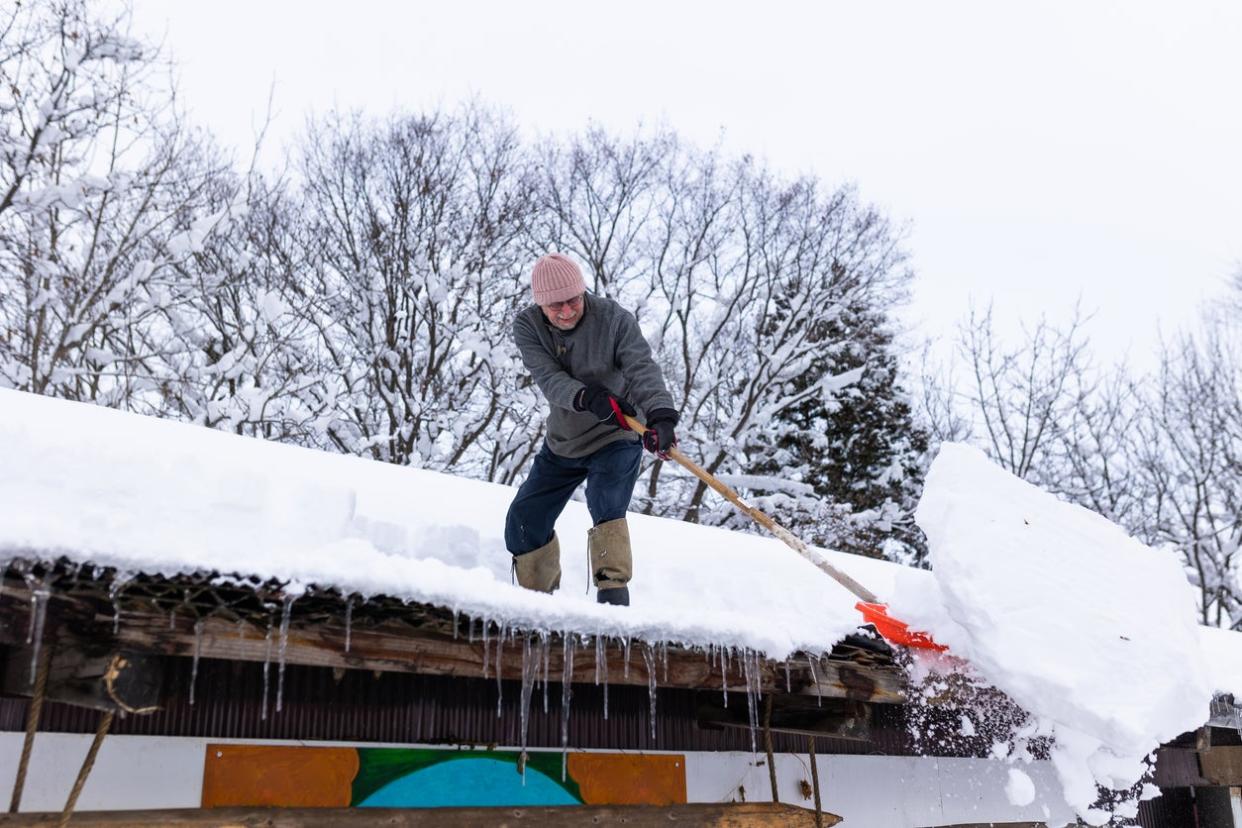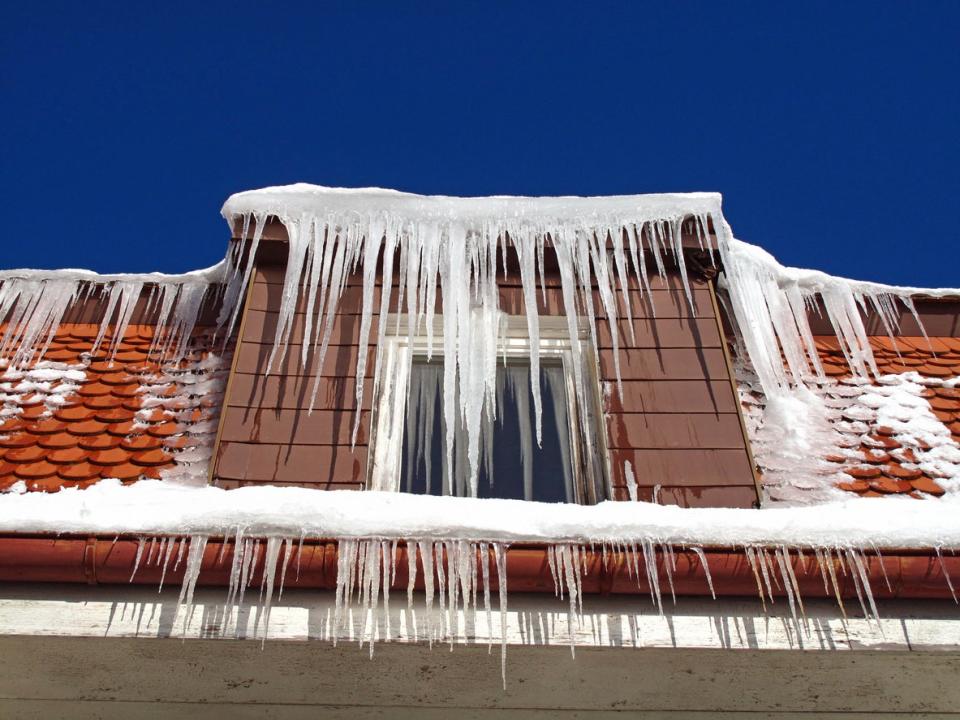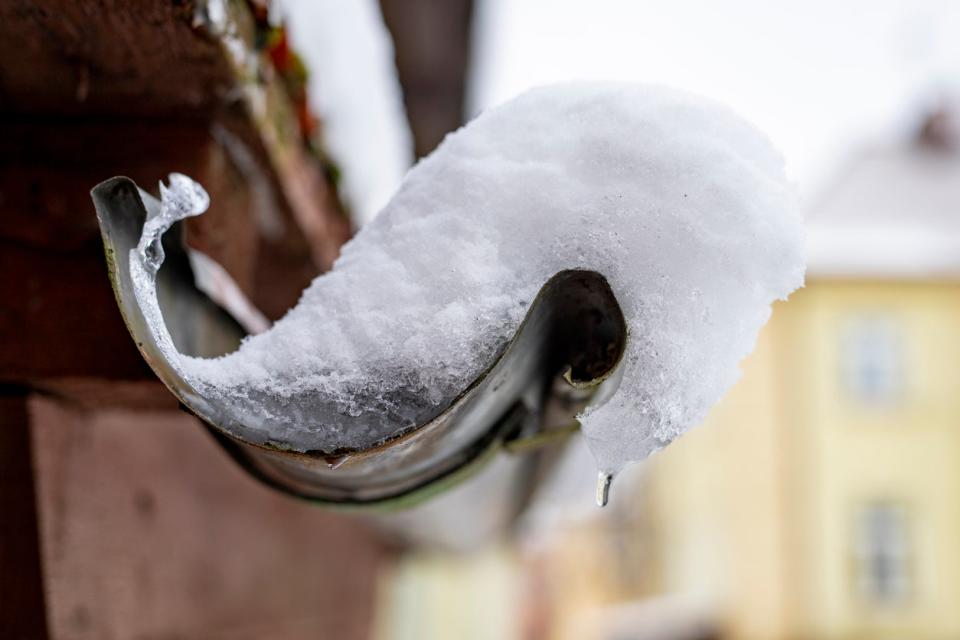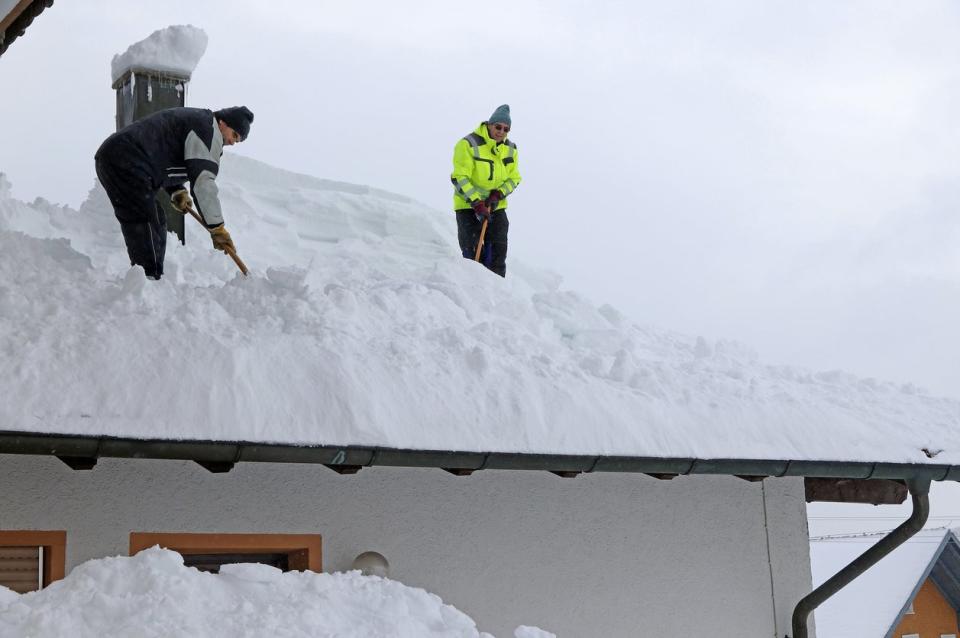How Much Does Ice Dam Removal Cost?

Highlights
The average ice dam removal cost is $1,200, but homeowners might spend between $400 and $4,000.
Several factors that affect the cost of removing ice dams include the size of the house or its roofline, the removal method, local labor rates, snow removal, or any additional inspections or roof repairs.
Unresolved ice dams can cause leaks inside the roof and walls of the house, which can lead to mold and other water damage that becomes costly to repair.
Snow and icy conditions make it challenging and risky to remove ice dams from a roof, which is why most homeowners prefer to hire snow removal specialists who have the equipment and experience to get the job done safely.
A line of frozen icicles may look enticingly nostalgic, but they can pose a danger to the home’s occupants and threaten the integrity of the roof. Icicles are usually an extension of an ice dam that occurs when frozen water builds up along the edges of a roof. It forms when there is a temperature difference between the main part of the roof and the outer edge that’s exposed to the elements. As the roof warms, snow melts and runs toward the gutters. If the temperature of the edge of the roof is below freezing, the water often refreezes and can build up over multiple freeze-thaw cycles.
Ice dams can cause numerous problems since they block the flow of melted water, causing it to seep under the roofing material instead of down the gutter. The ice dam can even work its way under the eaves or shingles where it can potentially cause mold or mildew issues and even structural damage. According to HomeAdvisor and Angi, ice dam removal costs an average of $1,200, but it can range from $400 to $4,000 depending on the severity of the ice dam and removal method, among other factors.
Factors in Calculating Ice Dam Removal Cost
The cost of ice dam removal is largely dependent on both the size of the roof and the ice dam, the removal method, and the cost of labor. Removal costs will vary depending on the snow removal service, since some methods carry more risk than others.

Photo: istock.com
Home Size
The size of the home, or more specifically, the size of the roof, has a big impact on ice dam removal cost. It will likely cost more to remove ice dams from a home with multiple levels since it may require more work to get to the second or third story of a home—and more risk, too. A single-story home with a 1,000-square-foot roof typically costs between $400 and $600 for ice dam removal, but a multistory home with over 1,500 square feet of roof can run from $2,000 to $4,000.
Removal Method
Recommended removal methods for ice dams on the roof vary depending on the severity of the ice dam and include using ice dam salt, roof melt tablets, high-pressure water, steam, and manual chipping. The cost per hour for each method typically depends on how difficult the job is. Some methods are better suited for small ice dams, while others are best for significant ice dams.
A professional will choose the best but easiest method to clear an ice dam and avoid having to get on ladders in the snow and ice. They’ll likely recommend ice dam salt or roof melt tablets before considering a more intensive job like chipping the ice manually or using steam to melt it. Any of these methods cost between $100 and $600 per hour, with most jobs requiring at least 2 hours or more to complete.
Labor
Removing ice dams can be dangerous work. The professional will likely be on a ladder or on the roof working in snowy and icy conditions—slippery conditions for anyone. As a result, the cost of an ice dam removal service may be more than homeowners expect: between $100 and $600 per hour. The good news is that the material and supply costs of this job are low, so the bulk of the cost depends on how long the ice dam removal actually takes.
Additional Costs and Considerations
While the size of the house and roof, the removal method, and the labor primarily make up the cost of ice dam removal, there are a few other factors to take into consideration. If snow needs to be removed from the roof or the gutters need to be cleaned, these tasks can add on extra time, which translates to higher labor costs. If the roof needs to be inspected, there will be additional costs for that service. If the roof sustained damage that needs emergency repairs or ice dam prevention measures are taken, then homeowners will pay more for the job.

Photo: istock.com
Snow Removal
In order to access the part of the roof that has the ice dam, snow removal may be necessary first. Snow removal professionals will need direct or close access to the ice dam, so if snow has accumulated on the roof throughout the winter, they’ll need to remove as much as they can to access the ice dam. Depending on the amount of snow, the snow removal cost may be included in the total price. But if it’s not, hiring snow removal services costs between $250 and $500.
Gutter Cleaning
Hiring a gutter cleaner to prepare the gutters for winter can help reduce the chance of ice dams caused by excess debris. As snow and ice melt off a roof, the water needs somewhere to go as gravity pulls it down. If the gutters are too full of debris to allow the water to run through them, then that can make the ice dam problem worse. Professional gutter cleaning costs between $119 and $228, but this cost may be added onto the bill if the ice dam removal service takes care of it with the owner’s permission.
Roof Inspection
A roof inspection can help identify any issues on the roof before they become problems, but it can also help determine the best course of action if a problem has already happened due to ice dam damage. If ice dams were a problem over the winter, homeowners will want to have a roofing professional take a look at the roof to determine what, if any, damage occurred as a result of the ice damming. Roof inspection cost typically averages $230.
Roof Damage Repair
In most cases, roof repair costs can fall between $300 and $1,800 or more depending on the actual amount of damage the ice dam did. Ice dams can cause the roofing material and structure to erode as well as cause damage to gutters and downspouts. In extreme cases, the entire roof may need to be replaced, which costs an average of $5,900 to $12,800.
Ice Dam Prevention
An ounce of prevention can go a long way. If homeowners want to avoid the cost involved with ice dam removal, it may be worth the time, effort, and cost to take ice dam prevention measures before winter. Several prevention techniques can help homeowners avoid ice dams altogether.
Clean the roof and gutters. Cleaning leaves, pine needles, sticks, and other debris out of gutters before winter can help prevent ice dams from forming since clean gutters allow water to flow away from the roof before it can freeze. Hiring a roof cleaning service, such as Window Gang or Window Genie, to clean the roof and gutters can cost between $150 and $225.
Install roof ridge vents. Roof ridge vents help circulate air through the attic, which can help keep the roof cooler in the winter and reduce the amount of snow melt that happens quickly. Many roofing companies can install ridge vents for between $300 and $550.
Cap the roof access hatch. If the roof includes a roof access hatch, it should be sealed to prevent hot air from escaping too quickly. To cap a roof access hatch, homeowners can expect to pay a professional between $50 and $100 per hour for the job.
Install roof heating cables. Roof heating cables can be installed on the lower portion of the roof, where it tends to get colder. The heated cables help prevent melting water from refreezing and creating an ice dam. This is a great way to melt ice without salt, and installation costs between $50 and $100.
Ice Dam Removal Cost by Type of Method
The severity of the ice dam will largely impact the method used to remove the ice dam. In some cases, salt or roof salt tablets can be used to encourage melting. In other, more severe cases, the best removal method may require steaming, pressure-washing, or physically chipping the ice off of the roof.
Ice Dam Removal Method | Average Cost Per Hour (Materials and Labor) | Average Time Required |
Chipping | $200 to $300 | 4 to 6 hours |
Pressure washer | $200 to $400 | 2 to 5 hours |
Salt and tablets | $100 to $150 | 1 to 2 hours |
Steam | $400 to $600 | 2 to 3 hours |
Chipping
Chipping the ice to remove the ice dam is the most labor-intensive ice dam removal method. It is also one of the more dangerous methods as the professional will have to be up on a ladder in snowy and icy conditions. This method could also damage the roof and gutters if not done properly. Due to the risks, this method will typically cost between $200 and $300 per hour.
Pressure Washer
The pressure-washing method of ice dam removal can effectively remove all snow and ice from the roof. There is some damage risk to the shingles, slate, or other roofing material, and it can cause unsealed or damaged roofs to leak. If the roof is known to be in good condition and the professional is experienced in pressure-washing snow and ice from a roof, then it’s a highly effective way to clear an ice dam. This method costs between $200 and $400 per hour to complete in about 2 to 5 hours.
Salt and Tablets
To encourage ice dams to melt, snow removal professionals will often use salt and roof melt tablets. Salt used to melt snow and ice is typically calcium chloride since it’s effective at melting ice in temperatures as low as -20 degrees Fahrenheit. If using roof melt tablets, the snow removal professional may be able to throw them onto the ice dam, avoiding the need for ladders and making the entire process safer. The cost for salt and tablet application is between $100 and $150 per hour.
Steam
Using steam to remove ice dams is the most expensive method, costing between $400 and $600 per hour, but it is also the most effective for huge ice dams. It typically takes just 2 to 3 hours to remove stubborn ice dams with steam.
Do I need ice dam removal?
Removing ice dams on roofs is beneficial and important for home maintenance during winter months. While homeowners don’t usually walk on the roof during the winter months, it’s important to keep an eye on the roof while standing on the ground. Ice dams can cause a lot of problems if left untreated, including structural damage, leaks, mold issues, and more. Usually, a large ice dam is easily visible due to the presence of numerous icicles, but ice dams often form long before a visible icicle appears.

Photo: istock.com
Icicles on Gutters
A few icicles hanging from the roof may be picturesque, but if a significant number begin to form, there’s a chance that an ice dam is responsible and action should be taken quickly. When an ice dam forms on the edge of the roof, additional water will continue to run down and freeze on the ice that’s accumulated on the edge. This freeze-thaw cycle will continue until resolved. If the ice gets too heavy, it could rip the gutters off, or the ice can work its way under the shingles and cause damage to the roof deck.
Ice on Exterior Walls
In some cases, water that melts on the roof and is rerouted away from the gutters by the ice dam will seep onto the exterior walls and freeze there. Ice on the exterior walls of the home should be assessed by a snow removal professional to determine the cause; this will allow them to take steps to remove the ice dam and inspect for damage.
Interior Water Damage
When an ice dam prevents water from running through the gutters and down the downspouts, any water that melts from the accumulated ice will often seep into the walls and cause interior water damage. If a homeowner sees water damage in their attic in the winter, it may be the result of an unaddressed ice dam.
Gutters Not Draining
If it’s clear that snow and ice are melting, but no water is coming through the downspout, it’s likely the result of an ice dam blocking the gutter. This can cause water to back up into the home, while the weight of the ice dam can damage the gutters.
Ice Dam Removal: DIY vs. Hiring a Professional
Homeowners often try to remove icicles by knocking them down, but that only resolves a symptom of the problem. Many homeowners may even attempt to throw some rock salt onto their roof, but this can be a slippery task if the area is covered in ice and snow. So while it may be tempting to attempt DIY ice dam removal, this is a job that is best left to a professional ice dam removal company.
Treacherous winter conditions can make getting up on the roof very dangerous, and homeowners often aren’t equipped with the right tools to steam, chip, or pressure-wash the ice dam away. Even applying salt to the ice dam will likely require getting up on a ladder or the roof itself and increase the risk of falling and sustaining an injury in icy conditions.
Hiring a professional to do the job comes with a cost, but it’s likely worth it to avoid a dangerous DIY situation. Best of all, a professional will have the eye to inspect for possible damage to the roof and gutters and possibly make temporary repairs to hold through the winter.
How to Save Money on Ice Dam Removal Cost
For homeowners keeping a close eye on the budget, it’s common to want to find ways to save on projects such as ice dam removal costs. The cost range is significant ($400 to $4,000), so homeowners are encouraged to try a few methods to save on the total price.

Photo: istock.com
Sign a seasonal contract. Some snow removal companies will offer a seasonal contract, sometimes at a reduced rate, which ensures homeowners have priority if the services are needed—even if the company is busy with other projects.
Keep up with seasonal maintenance. Doing seasonal maintenance like cleaning the gutters and ensuring proper ventilation can help avoid ice dam problems in the first place. This can save homeowners money on ice dam removal and repairs.
Get quotes from multiple companies. The first sign of an ice dam is the best time to start calling snow removal companies. An emergency situation doesn’t always allow for price shopping, so homeowners are encouraged to obtain quotes from a few companies to compare the cost and the services they offer. The best roofing companies include Aspen Contracting, CMR Construction, and Power Home Remodeling.
Request lower-cost methods first. Depending on the snow removal company, homeowners can ask about lower-cost removal methods first, like roof melt tablets or salt. If those methods don’t work, however, homeowners may end up paying more for the professional to try multiple methods.
Questions to Ask About Ice Dam Removal
While ice dams can be a common issue, for homeowners who haven’t dealt with them before, it’s a good idea to ask the snow removal professional a few questions to understand the process, the methods, and the price.
Are you insured for ice dam removal?
What methods will you use to remove the ice dam?
Do you offer a written quote? How accurate do your quotes tend to be?
Is there a minimum charge to remove an ice dam?
How long will removal take?
How many visits will you be making?
Do you return to make sure the ice dam is gone?
Do I need to be present when you’re doing the work?
If there is damage to the roof or gutters, do you handle repairs or do you have contractors you could recommend?
FAQs
In many areas, winter brings extra work when it comes to snow removal around the house. So, if ice dam removal is necessary, homeowners will want to resolve it as quickly and painlessly as possible. Here are a few commonly asked questions and answers about ice dam removal that can help homeowners get a handle on the situation.
Q. Is ice dam removal worth it?
Yes. Due to the potential ice dams have to create lasting damage to the roof, the structure, and the interior of the home, ice dam removal is worth it. The cost can definitely put a dent in the budget, but it can also prevent the higher costs of home repairs when the ice dam is left unchecked.
Q. How long does it take to remove ice dams?
Ice dam removal typically takes at least 2 hours. Methods such as steaming, pressure-washing, and chipping require more intensive labor time—up to 6 hours. Salt or ice melt tablets can be applied quickly but will take longer to work, and the snow removal service may need to return after a few hours or even a few days to make sure the ice dam is actually gone.
Q. Can I use hot water to remove ice dams?
Hot water can be used to remove ice dams, but it requires climbing onto a snowy, icy roof. Most homeowners prefer to leave it to a snow removal professional who can slowly pour hot water on the ice dam, allowing it to melt into the gutters. As the ice loosens and breaks up, they can push the larger chunks off of the roof. This method is effective and best left to a professional.
Sources: Angi, HomeAdvisor

